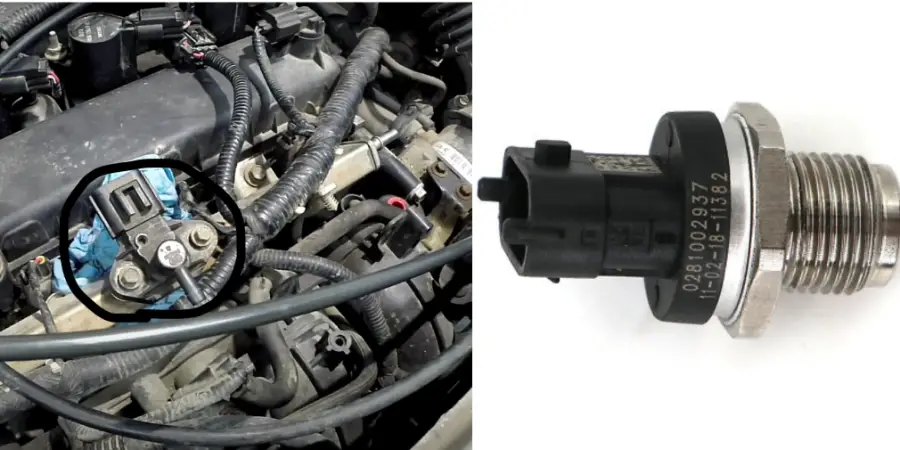
Received the P0191 Code on your Dodge Cummins? That’s a bummer, but here’s something that might cheer you up: it’s one of the most common problems of vehicles running under the Cummins. And if a problem is common, the solution must be easy to access.
Your vehicle is receiving the P0191 code because of a failed fuel rail pressure sensor. If this sensor fails, the central module of the vehicle will malfunction, for it operates based on the sensor’s readings. However, this error may be caused by other components too.
The fuel rail pressure sensor doesn’t receive much attention, but it’s a somewhat important component.
This article will elaborate on how it works, how a failed sensor leads to performance issues, and also guide you on some fixes. Let’s get your vehicle back on track!
How the P0191 Error Code Is Produced
The Cummins, in general, is one of the sturdiest engines out there. Even buses make use of it! However, it cannot be denied that it still has a long way to go before becoming seamless.
To keep your engine running optimally, the Dodge Cummins strategically uses fuel for maximum efficiency. For example, if your vehicle accelerates, more fuel will be pumped to power the many engine components responsible for speeding it up.
However, some driving circumstances require a lower fuel volume, and the entire engine must adjust. It achieves this by modifying the pressure of the fuel as it passes along the pipelines.
The whole fuel system is based on demand, as outlined below.
1. Fuel Passes Through Filters and Valves
Pumps found on the lower part of the Diesel engine push the fuel from the fuel tank onto the pipeline. Before it reaches the pipeline, it passes through a filter housing to ensure that no foreign material gets onto the injectors.
It is further regulated by a valve that keeps the fuel volume in check. A dedicated control unit controls the valve according to driving circumstances. The fuel that passes through the valve is fed to the high-pressure pump.
2. A High-Pressure Pump Compresses Fuel
This high-pressure pump is housed in a cylinder and performs a constant push-pull motion. The cylinder it’s housed in is large enough for a vacuum to form whenever the high-pressure pump is in a pulling motion.
Because of the vacuum created, fuel is suctioned from the inlet valve and onto the cylinder. Once it is in, the push motion of the pump compresses the fuel and feeds it onto a much smaller pipeline.
Because of the compression and the smaller pipeline, the fuel is now moving at a certain amount of pressure. The pipeline then bends the trajectory of the fuel onto another chamber called the rail.
Note that another regulator is in place along the pipeline to control the pressure passing through and avoid sudden fluctuations in fuel.
3. Fuel Travels Through the Rail
With the fuel in the rail, it is ready to be passed onto the injectors. These injectors are the ones that actually pump fuel into the needed components. But before anything, a dedicated component is placed along the rail to monitor the pressure of the fuel within.
This component is called the fuel rail pressure sensor (FRPS), and it reports the pressure reading to the engine control module (ECM). Think of the ECM as the central brain of the vehicle.
4. ECM and FRPS Coordinate To Control Fuel Pressure
The ECM then takes the readings from the FRPS as a reference to dictate the mechanisms of all of the fuel regulators. For example, suppose it reads insufficient pressure when the engine requires more fuel. In that case, it tells the valves to loosen and pressure pumps to increase power.
When the FRPS breaks, the ECM most likely does not get any readings or gets readings that need to be clarified. When this happens, an irregular or insufficient amount of fuel is pumped into the engine, leading to stalling, jerking, and other performance issues.
The ECM is intelligent enough to detect when it’s precisely the FRPS that is faulty. Whenever this happens, it alerts your car via the code P0191.
Symptoms of a Faulty Rail Pressure Sensor
Since the FRPS is a crucial fuel system component, various car problems may manifest if it’s faulty. Here are two of them:
Engine Failure
When the pressure sensor does not provide the ECM with any reading, the high-pressure pumps may churn out a complete lack of fuel. Naturally, the engine will not operate when there’s no fuel. If it runs, your car will likely keep stalling or randomly slowing down.
Surging and Jerking
Surging occurs when the car receives a sudden fuel boost, and the engines operate with an excess of it. Your car may suddenly go into overdrive and operate much faster than you would want.
This results when the FPSR does not provide accurate pressure. The ECM, as a result, may demand more from the pumps than the engine needs.
Taking the Fuel Rail Pressure Sensor Out

Luckily, the fuel rail pressure sensor is relatively easy to find. What makes it a bit complicated, however, are the many wires and pipes connected to it.
Here’s how to take it out.
1. Use a 27-Millimeter Wrench To Loosen the Sensor
The first thing you must do is disconnect the truck from any power sources. Working with electricity, especially with engines that require high voltage, is dangerous.
Next, locate the FRPS and disconnect the wires from the sensor. Note that another sensor is located near the FRPS, whose wires you must also disconnect to get better access. The FRPS can be removed with a 27-millimeter socket wrench.
2. Remove Pressure Before Taking It Out
Before removing the FRPS, ensure the pipelines have no pressure. The sensor can fly onto you if you don’t do this, which may cause some injuries.
Once you’ve loosened the sensor, check the sensor’s base for oil. Also, check for debris from the fuel.
3. Do Further Diagnostics Before Replacing the Sensor
Note that the P0191 code doesn’t guarantee a fault on the FRPS. Sometimes, the ECM immediately interprets irregular pressure as an FRPS problem when it could be the fault of the regulators and the valves.
Furthermore, there could be issues in the wiring that goes into the FRPS. Three types of wires go in; the power, the signal, and the ground. Each holds specific voltages. What you can do is test the voltages on each of the wires.
4. Voltage Test the Sensor’s Wiring
Voltage testing is done with the key on and the engine off.
Refer to your car manual and locate the FRPS wiring diagram. It should tell you the proper voltage of each of the wires.
Once you know what the voltage should be, proceed to test each wire using a multimeter and a reliable pin. Insert the pin onto the end of the wire and test whether enough electricity is passing through it.
For example, the power and signal wires usually have a standard voltage of 5 volts. Check if this is accurate. Refer to the wiring diagram to find which area of the connector head corresponds to what wire.
If the voltage does not match, particularly if it’s way lower than the appropriate voltage, you may have to replace the wires and not necessarily the sensor itself. Do the same for the ground wire and replace it if needed.
If all three wires match the voltages stated in the wiring diagram, test the connector head. Insert the pin onto the connector head and check if enough voltage passes.
5. Examine the High-Pressure Pump
Another possible culprit could be the high-pressure pump. Sometimes, it doesn’t deliver the right amount and pressure of fuel. You can use a diagnostic scan tool to see if it’s faulty. If your findings point to the sensor as the culprit, replace it.
Note that if you overlook other possible culprits, you’ll probably only temporarily solve the problem, and the code will keep reappearing. So be patient with the diagnostics.
Replacing the Fuel Rail Pressure Sensor
With the old sensor out and the replacement sensor at hand, you may begin cleaning the area where the old sensor used to be. It may be filled with oil as well.
It’s super important that you double-check the replacement sensor. Since FRPS problems are common, there is a huge market for FRPS replacements.
Some parts sellers take advantage of this demand by selling counterfeits, so make sure what you’re getting is genuine and high-quality.
Also, double-check the replacement for possible dirt and other defects. If there aren’t any issues, you may attach the replacement to your engine. This is relatively easy to do by hand:
- Using a 27-millimeter socket wrench, tighten the placement of the FRPS. Make sure it doesn’t wobble.
- Plug the sensor’s connectors back in and do the same for the booster pressure sensor.
- If you don’t see any leaks, you can start your car to see if the problem persists.
Conclusion
The fuel rail pressure sensor is an efficient tool that ensures the right amount of fuel is fed onto your engines. When this fails, several complications may arise.
However, you need to be careful with placing the blame on your sensor, as other causes may also be to blame.
Other Dodge Cummins error codes and how to fix them:
